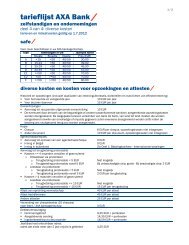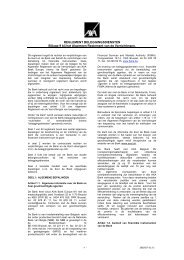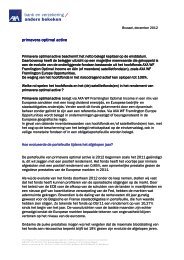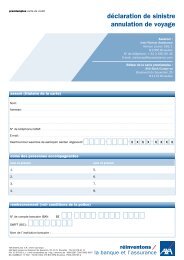AXA WORLD FUNDS A LUXEMBOURG INVESTMENT FUND ...
AXA WORLD FUNDS A LUXEMBOURG INVESTMENT FUND ...
AXA WORLD FUNDS A LUXEMBOURG INVESTMENT FUND ...
Create successful ePaper yourself
Turn your PDF publications into a flip-book with our unique Google optimized e-Paper software.
5. Risk linked to high yield debt securities<br />
Some of the high yield securities held in the portfolio may involve increased credit and market risk; such securities<br />
are subject to the risk of an issuer’s inability to meet principal and interest payments on its obligations (credit risk)<br />
and may also be subject to price volatility due to such factors as interest rate sensitivity, market perception of the<br />
creditworthiness of the issuer and general market liquidity. In selecting securities, the Sub-Fund will consider among<br />
other things, the price of the securities, and the issuer’s financial history, condition, management and prospects. The<br />
Sub-Fund will endeavour to mitigate the risks associated with high yield securities, by diversifying its holdings by<br />
issuer, industry and credit quality.<br />
6. Risk linked to Collateralised Debt Obligations securities markets<br />
Securities issued by Collateralised Debt Obligations («CDO Securities») are generally limited recourse obligations of<br />
the issuers thereof payable solely from the underlying assets («CDO Assets») of the relevant issuers or proceeds<br />
thereof. Consequently, holders of CDO Securities including the Company must rely solely on distributions on the<br />
CDO Assets or proceeds thereof for payment in respect thereof. In addition, interest payments on CDO Securities<br />
(other than the most senior tranche or tranches of a given issue) are generally subject to deferral. If distributions on<br />
the CDO Assets (or, in the case of a market value CDO Securities - as explained hereinafter) - proceeds from the<br />
sale of the CDO Assets) are insufficient to make payments on the CDO Securities, no other assets will be available<br />
for payment of the deficiency and following realisation of the underlying assets, the obligations of the issuers of the<br />
related CDO Securities to pay such deficiency including to the Company will be extinguished.<br />
With a market value CDO deal, principal and interest payments to investors come from both collateral cash flows as<br />
well as sales of collateral. Payments to tranches are not contingent on the adequacy of the collateral's cash flows,<br />
but rather the adequacy of its market value. Should the market value of collateral drop below a certain level,<br />
payments are suspended to the equity tranche. If it falls even further, more senior tranches are impacted. An<br />
advantage of a market value CDO is the added flexibility they afford to the portfolio manager. It is not constrained by<br />
a need to match the cash flows of collateral to those of the various tranches.<br />
CDO Assets consist primarily of non-investment grade loans, interests in non-investment grade loans, high yield debt<br />
securities and other debt instruments, which are subject to liquidity, market value, credit, interest rate, reinvestment<br />
and certain other risks. The CDO Assets will generally be subject to greater risks than investment-grade corporate<br />
obligations. Such investments are normally considered speculative by nature. CDO Assets are typically actively<br />
managed by an Investment Manager and, as a result, CDO Assets will be traded, subject to rating agency and other<br />
constraints, by such Investment Managers. The aggregate return on the CDO Assets will depend in part upon the<br />
ability of the relevant Investment Manager to actively manage the related portfolio of the CDO Assets.<br />
The CDO Assets will be subject to certain portfolio restrictions as set forth herein. However, the concentration of the<br />
CDO Assets in any one securities type subjects the holders of CDOs to a greater degree of risk with respect to<br />
defaults on the CDO Assets.<br />
The CDO Assets are subject to credit, liquidity, market value, interest rate and certain other risks. These risks could<br />
be exacerbated to the extent that the portfolio is concentrated in one or more particular CDO Assets.<br />
CDO Securities are in general privately placed and offer less liquidity than other investment-grade or high-yield<br />
corporate debt. They are also generally issued in structured transactions with risks different from regular corporate<br />
debt. In addition, the assets collateralising market value CDO Securities are subject to liquidation upon the failure of<br />
certain tests, and it is likely that any such liquidation would result in a substantial loss of value of the related market<br />
value CDO Securities.<br />
Prices of the CDO Assets may be volatile and will generally fluctuate due to a variety of factors that are inherently<br />
difficult to predict, including but not limited to changes in interest rates, prevailing credit spreads, general economic<br />
conditions, financial market conditions, domestic and international economic or political events, developments or<br />
trends in any particular industry, and the financial condition of the obligors of the CDO Assets. In addition, the ability<br />
of the issuer to sell CDO Assets prior to maturity is subject to certain restrictions set forth in the offering and<br />
constitutive documents of the relevant CDO.<br />
7. Risks linked to Investments in specific sectors or asset classes<br />
Certain Sub-Funds concentrate their investments in certain asset classes (commodities, real estate) or in companies<br />
of certain sectors of the economy and are therefore subject to the risks associated with concentrating investments in<br />
such classes and sectors. This type of strategy may lead to adverse consequences when such asset classes or<br />
sectors become less valued or less liquid.<br />
8. Risks linked to investments in specific countries or geographical zones<br />
Sub-Funds concentrating their investments in certain countries or geographical regions are therefore subject to the<br />
risks associated with concentrating investments in regions. This type of strategy may lead to adverse consequences<br />
when target markets drop or encounter liquidity issues.<br />
356
















